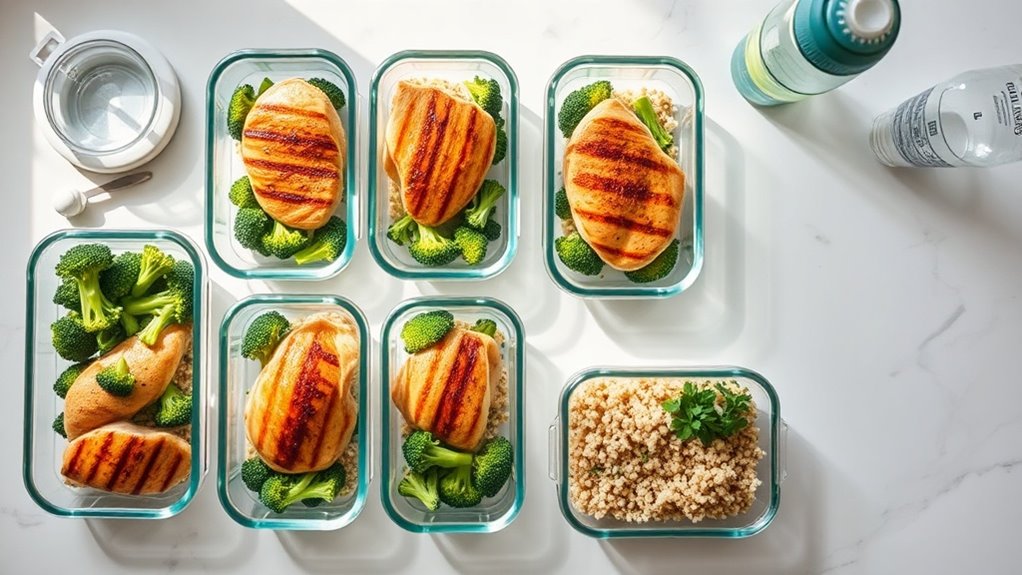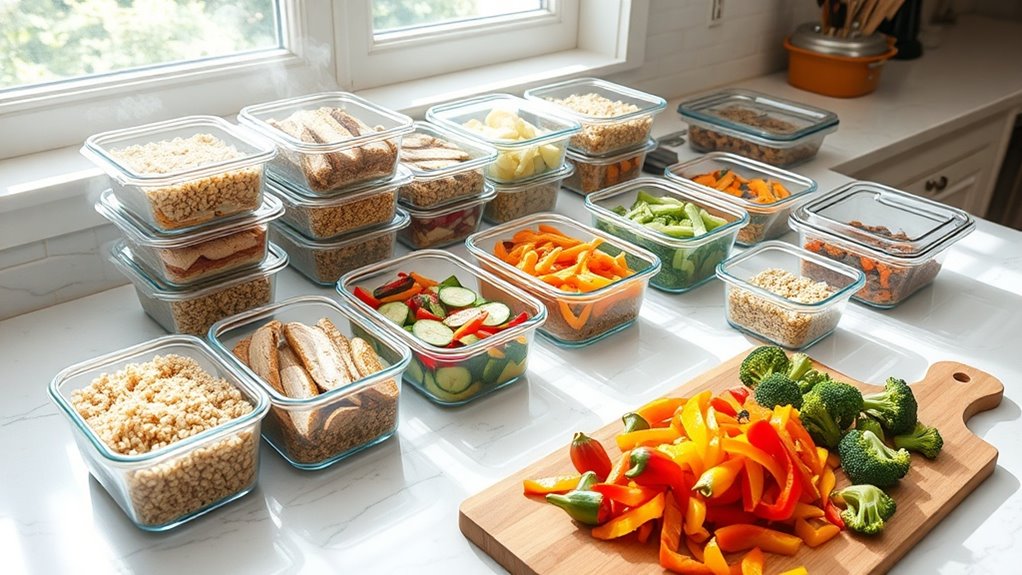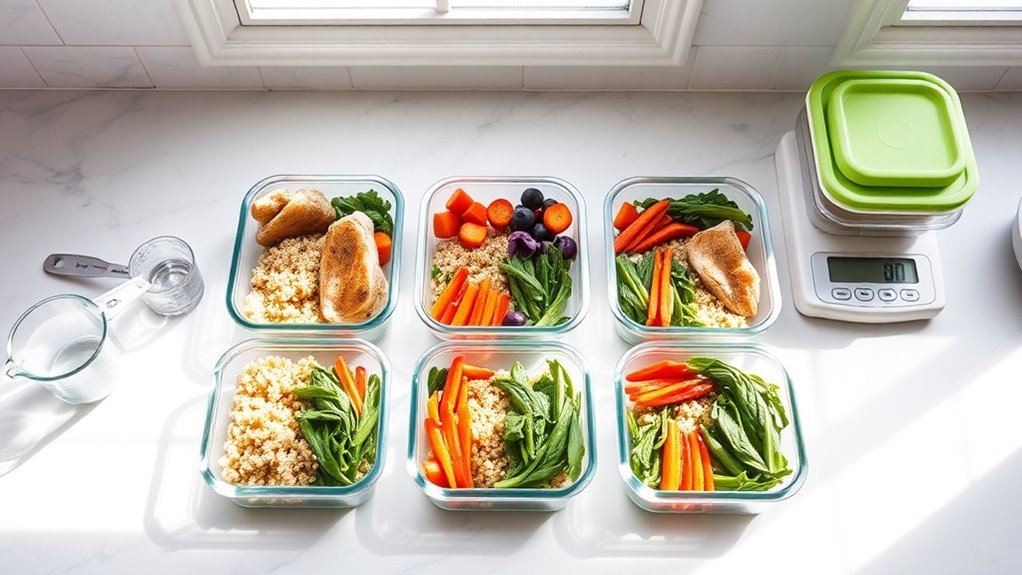You’ve Been Planning Meals Wrong-Fix This to Burn More Fat
Much like a well-tuned machine, your body operates best with the right fuel at the right time. If you’ve been overlooking meal timing and macronutrient balance, you might be sabotaging your fat-burning efforts. Small, protein-rich meals spaced throughout the day can maintain your energy levels and enhance muscle recovery. But there’s more to it than just timing; understanding the intricate roles of macronutrients is crucial. Let’s explore how to optimize your meal planning for better results.
Key Takeaways
- Schedule regular meal times to maintain steady energy levels and enhance fat oxidation for efficient fat burning.
- Balance macronutrients by incorporating proteins, healthy fats, and complex carbohydrates to create a calorie deficit while supporting overall health.
- Avoid overcomplicating meals; simplify prep to save time and reduce stress, promoting consistent healthy eating habits.
- Use portion control to prevent overeating and ensure you’re consuming the right amount of nutrients for fat loss.
- Incorporate variety in your meals by exploring different proteins, grains, and vegetables to prevent fatigue and sustain long-term healthy eating.
Understanding the Importance of Meal Timing
Have you ever wondered how the timing of your meals affects your fat-burning potential?
Research shows that when you eat can significantly influence your metabolism and fat loss results.
For effective meal prep for fat loss, consider spacing your meals to maintain steady energy levels and curb hunger.
Eating smaller, frequent meals throughout the day can help regulate blood sugar and enhance fat oxidation.
Additionally, consuming protein-rich meals before and after workouts may optimize muscle recovery and fat utilization. Setting a cut-off time for eating can also improve digestion and boost your overall energy levels.
The Role of Macronutrients in Fat Loss
Understanding the role of macronutrients is crucial for effective fat loss.
Each macronutrient plays a unique role in your body and can impact your weight loss journey.
Here’s what you need to know:
-
Proteins: Essential for muscle repair and growth, helping you maintain muscle while losing fat.
-
Fats: Healthy fats support hormone production and satiety, making it easier to stick to your diet.
-
Carbohydrates: Provide energy for workouts; opt for complex carbs for sustained energy.
-
Balance: Aim for a macronutrient ratio that suits your lifestyle and promotes a calorie deficit for fat loss. Additionally, meal planning can significantly enhance your ability to manage these macronutrients effectively.
Common Meal Prep Mistakes to Avoid
Meal prepping can be a game-changer for staying on track with your fat loss goals, but common mistakes can sabotage your efforts. Here are some pitfalls to avoid:
| Mistake | Consequence | Solution |
|---|---|---|
| Overcomplicating meals | Increased prep time | Keep it simple and balanced |
| Ignoring portion sizes | Overeating | Measure portions accurately |
| Lack of variety | Meal fatigue | Rotate ingredients weekly |
| Skipping prep days | Last-minute poor choices | Schedule prep days on your calendar |
To maximize your meal prep success, ensure you’re following key principles of effective meal prep to streamline your cooking process.
Effective Strategies for Meal Planning
Effective meal planning can significantly enhance your fat loss journey by providing structure and consistency.
To optimize your approach, consider these strategies:
- Set a Weekly Schedule: Dedicate specific days for planning, shopping, and prepping meals.
- Focus on Macronutrients: Balance proteins, carbs, and fats to support your energy needs and recovery.
- Use Portion Control: Measure servings to prevent overeating and ensure you’re consuming the right amounts.
- Choose Whole Foods: Prioritize fresh, unprocessed ingredients to maximize nutrient intake and minimize added sugars.
Additionally, incorporating daily journaling into your meal planning can help track your food intake and feelings, promoting a more mindful approach to eating.
Implementing these strategies will help you streamline your efforts and promote sustainable fat loss.
Incorporating Variety to Boost Metabolism
Incorporating a variety of foods into your meal plan can significantly boost your metabolism. Try to include diverse food choices, swap in seasonal ingredients, and experiment with flavorful cooking techniques. These small changes can keep your meals exciting and help your body burn more fat efficiently. Additionally, eating balanced meals every 3-4 hours can keep your metabolism active throughout the day.
Diverse Food Choices
How can you keep your metabolism firing on all cylinders?
One effective strategy is to incorporate diverse food choices into your meals.
This not only keeps things interesting but also fuels your body differently.
Here are four ways to enhance variety:
- Explore different proteins: Try lean meats, legumes, or fish.
- Mix up your grains: Switch between quinoa, brown rice, and farro.
- Add colorful veggies: Include greens, reds, and yellows for antioxidants.
- Experiment with spices: Use herbs and spices to boost flavor and metabolism.
Seasonal Ingredient Swaps
Are you ready to maximize your meals with seasonal ingredient swaps?
Incorporating seasonal produce not only adds variety but also boosts your metabolism.
Fresh, in-season fruits and vegetables are packed with nutrients, making them more flavorful and beneficial.
For example, swap winter squash for zucchini in the summer or use berries instead of apples in autumn recipes.
These ingredients often have higher vitamin content and antioxidants, which can enhance fat burning.
Plus, buying local and seasonal reduces costs and supports your community.
Embrace these swaps to keep your meals exciting and your metabolism fired up!
Flavorful Cooking Techniques
To truly elevate your meal planning and metabolism, exploring flavorful cooking techniques is key.
By incorporating variety, you can keep your meals exciting and beneficial. Here are four techniques to consider:
- Grilling: This method enhances flavors without added fats, promoting lean protein consumption.
- Sautéing with spices: Using herbs and spices can boost flavor and metabolism, thanks to compounds like capsaicin in chili.
- Roasting: Caramelizing vegetables intensifies their natural sweetness, encouraging more plant-based meals.
- Steaming: Retains nutrients while allowing you to experiment with various seasonings for added taste.
Embrace these techniques to maximize your meal benefits!
Building Sustainable Eating Habits for Long-Term Success
Why settle for quick fixes when building sustainable eating habits can lead to lasting success in your fat loss journey?
Start by prioritizing whole foods—think fruits, vegetables, lean proteins, and whole grains. Plan your meals around these staples to ensure balance.
Practice mindful eating; savor each bite, and listen to your body’s hunger cues. Gradually introduce changes to avoid overwhelming yourself.
Aim for consistency, not perfection, and allow occasional treats to prevent feelings of deprivation. Additionally, consider habit stacking to seamlessly integrate healthier eating habits into your daily routine.





